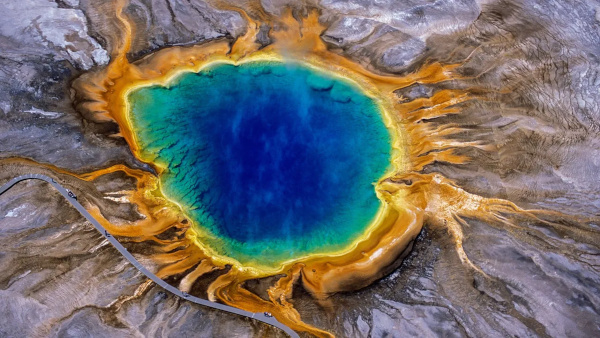
Image: Steam rises from the Grand Prismatic Spring, one of the most fascinating hydrothermal surfaces in Yellowstone National Park.
Credit: TOM MURPHY National Geographic Create
The Yellowstone Supervolcano is a volcanic system located primarily in Yellowstone National Park in the northwestern United States. It is considered to be one of the largest supervolcanoes in the world and has experienced three major supereruptions in the past million years, since animated by more discreet telluric phenomena.
The Yellowstone supervolcano is characterized by a large caldera, which is a geological depression resulting from the collapse of the ground after a major volcanic eruption. The Yellowstone Caldera is about 72 km long, 55 km wide, and covers an area of about 1,500 square kilometers. It is dominated by Yellowstone Lake and is surrounded by the Rocky Mountains.
Beneath the Yellowstone caldera is a huge magma chamber, which is an underground store of molten magma. The Yellowstone magma chamber is particularly large and is estimated to be several tens of km wide and several tens of km deep. It contains huge amounts of magma, which can fuel volcanic eruptions of exceptional magnitude.
Yellowstone is famous for its geothermal activity, which manifests itself in the presence of geysers, hot springs and bubbling mud pools. Yellowstone's most famous geyser is Old Faithful, which regularly erupts, shooting hot water and steam into the air. Geothermal activity is the result of the interaction between hot magma and underground water reservoirs.
Over the past million years, the Yellowstone supervolcano has experienced three major supereruptions, which are considered to be among the most powerful volcanic eruptions in Earth's history. These supereruptions occurred approximately 2.1 million, 1.3 million, and 640,000 years ago. They threw immense amounts of volcanic ash, gases and materials into the atmosphere, altering the surrounding landscape and having a significant impact on the global climate.
The supervolcano is characterized by periods of seismic and geothermal activity, followed by periods of calm. Over time, it has experienced cycles of major volcanic eruptions, separated by periods of inactivity that can last thousands or even millions of years. Supereruptions occur only rarely on a planetary scale (≈every 650,000 years).
The Gutenberg-Richter law is an empirical law that applies to many types of catastrophic phenomena, such as earthquakes, volcanic eruptions, floods, hurricanes, tsunamis, avalanches, etc.
Formula: log N = a - bM
- log N represents the decimal logarithm of the total number of earthquakes with a magnitude equal to or greater than a given value,
- M is the limiting magnitude from which earthquakes are included in the analysis,
- a is a parameter which determines the level of basic seismic activity,
- b is a coefficient that controls the decrease in earthquake frequency with increasing magnitude.
In other words, this formula indicates that the number of earthquakes of a given magnitude is proportional to a negative power of the magnitude. Thus, as the magnitude of earthquakes increases, their number decreases exponentially.
There are about 1,500 active terrestrial volcanoes, of which around 60 erupt every year.